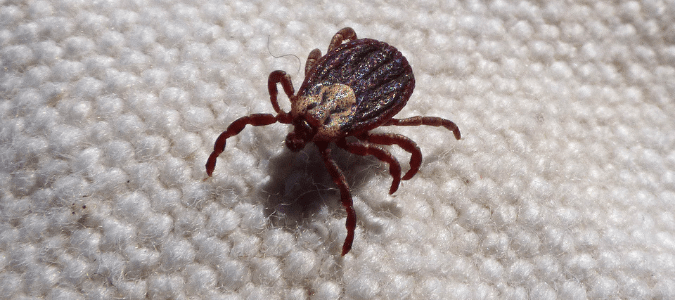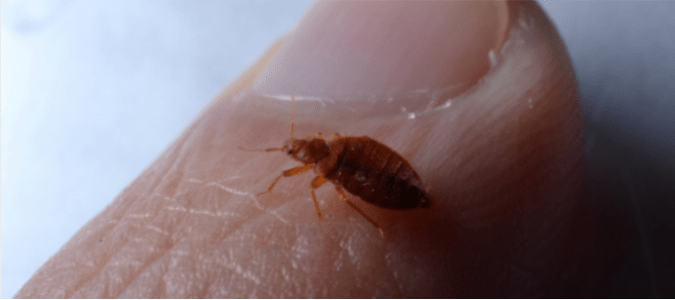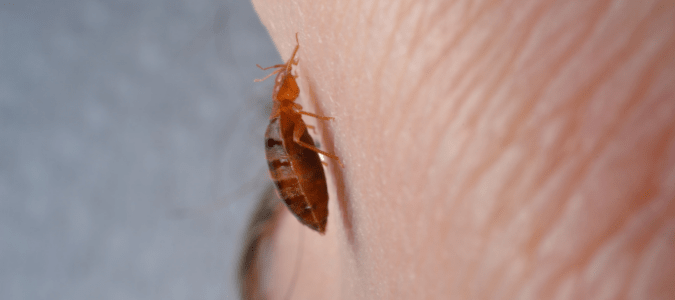
After spotting a tiny bug in your house, you are understandably freaked out. Could it be a bed bug, or was it actually a tick? If you’re being honest with yourself, it could be any kind of pest, and you wouldn’t know the difference. Even if you did, these insects are so small it can be hard to tell them apart.
While bed bugs and ticks feed on blood and most types are flat and rounded, that is not always the case. If you are wondering if it’s a bed bug or tick that you have seen, you should know that bed bugs are usually found indoors, while ticks most often inhabit wooded or grassy areas outside. While a bed bug might bite you several times when you are asleep, a tick will latch onto you and feed for several days until it’s full.
It can be hard to tell a tick and a bed bug apart by sight, especially since there is one species of bed bug and several species of ticks you may encounter. Ticks are arachnids, so these creatures have 8 legs, while bed bugs are insects with 6 legs. While ticks prefer animal blood, they will feed on humans, whereas bed bugs would choose a human over an animal for a blood meal.
In this post, we’ll tell you more about each of these creatures, and what to do if you discover one inside your home.
We’ll start with bed bugs.
Signs Of A Bed Bug Infestation At Home
Human dwellings are an ideal habitat for bed bugs because they provide easy access to hosts. These pests commonly infest large buildings like hotels, dorms, theaters and apartments, but they can also be found in residential areas as well.
A popular misconception is that bed bugs will only thrive in an unkempt home, but that’s not necessarily the case. Bed bugs can infest even the cleanest of homes, and all it takes is for someone to accidentally bring one home for a problem to get started.
Modern travel has made it easy for bed bugs to be dispersed from one corner of the country to the next. Travelers may pick up the bugs from hotels, the homes they visit, buses, trains and even planes. These tiny parasites will then be unknowingly brought into a home, hidden within infested luggage and clothing. After that, the bugs will multiply as they feed on their human hosts, and sooner or later, you’ll face a full-blown bed bug infestation.
Even if you don’t travel, you can still come into contact with bed bugs. Secondhand furniture, suitcases, purses and other bags are also possible ways to bring bed bugs into your home.
Bed bugs are incredibly good at hiding. These minuscule creatures can squeeze into unbelievably tiny crevices. The most favored hiding spots for bed bugs include behind headboards, in the folds of mattresses, inside box springs, beneath loose flooring, in upholstered furniture and behind loose wallpaper.
How do you know if you have a bed bug infestation? You may have a problem on your hand if you experience:
- Unexplained itchy bites on your body—especially when you get up in the morning.
- Very small rust-colored blood spots on your bed sheets.
- Dark fecal spots on your bedding.
- Molted skins shed by bed bugs as they grow.
Since living bed bugs and some of these other signs are incredibly hard to spot, the most obvious tip-off is the bites themselves, which can be confused with other types of insect bites. If you notice any of these warning signs, or wonder if it’s really bed bugs that you are dealing with, it’s best to call in a pest control professional to assess the situation and recommend a treatment plan.
If you do see a live bug, how do you know if it’s a bed bug? Read on to learn more.

What Do Bed Bugs Look Like?
Once the infestation has gone on for some time and the number of bed bugs has grown, it is likely that you will eventually see these pests. How will you know you have bed bugs? Here are some distinguishing characteristics:
- Adult bed bugs measure approximately a quarter inch in length. These parasites are just as wide as they are long, and are a reddish-brown color.
- Immature bed bugs are much smaller than adults and are somewhat translucent. If you look close enough, you’ll notice they are white-yellow in color.
- The body of a bed bug is flattened horizontally.
- Bed bugs have six slender legs.
- The long, segmented proboscis (mouthparts) on the head is usually hidden beneath the bed bug’s body and projected backward when the bug isn’t feeding. However, when the bed bug takes a blood meal, the proboscis elongates and projects forwards.
- A bed bug that has just had a blood meal becomes more rounded and somewhat torpedo-shaped. Its color also gets more deeply pigmented because of the blood it has just consumed.
If the bug you saw does not fit this description, what else could it be?

Tiny Bugs In Bed That Aren’t Bed Bugs
With bed bug infestations on the rise over the past few years, there has been growing anxiety among homeowners who are paranoid about being exposed to bed bugs. As a result, it’s becoming more and more common for people to see bugs near their bed and simply assume that they’re bed bugs.
The most common bugs that look like bed bugs include bat bugs, immature roaches, carpet beetles, spider beetles and wood ticks.
Bat Bugs
A distant relative of the bed bug that feeds on blood from bats. These creatures are commonly found in attics near bat roosts.
Cockroach Nymphs
A newly-hatched cockroach almost looks like a bed bug. However, as the roaches grow and molt, it becomes much easier to tell a cockroach from a bed bug.
Carpet Beetles
Although these bugs have a shape similar to a bed bug’s, their bodies aren’t flat. They also feed on fabric and clothing, unlike bed bugs, so you won’t have to worry about these bugs biting you.
Spider Beetles
Much like bed bugs, spider beetles like to hide in cracks and crevices. However, these creatures only eat plant-based materials and aren’t flat like bed bugs.
Wood Ticks
Also known as dog ticks, these creatures are flat and oval-shaped, which explains why someone might easily mistake them for bed bugs. Another reason for the confusion is that wood ticks also feed on blood. While bed bug bites can be irritating and an infestation can become emotionally exhausting, ticks can spread several dangerous diseases when they bite.
To the untrained eye, many of these bugs can look quite similar. The easiest way to address your concerns about any insects you might find in your home is to call in an experienced pest control professional to identify the bug and determine whether you have an infestation.
Types Of Ticks
Many different tick species exist here in the U.S. and each species is a little different from the rest. Some of these distinctions may be so subtle that only a skilled entomologist or pest control professional would be able to determine the specific type of tick in your home.
Some of the tick species that homeowners in the U.S. encounter in their homes and on their pets include:
Dog Ticks
These ticks will feed on pets and humans. Other names for the dog tick include the brown dog tick, the American dog tick and the wood tick.
Deer Ticks
While you should still pay attention to any tick that makes its way into your home, don’t be too worried about deer ticks, as they rarely feed on pets or humans.
Lone Star Ticks
As with deer ticks, lone star ticks rarely feed on us or our pets.
These aren’t the only tick varieties that you can find on your pet, in your home or on your body. Nevertheless, dog ticks are by far the most commonly encountered tick species as they are easily brought into our homes by our beloved pets.
It’s one thing if you find a tick on your dog. If you and your furry family member sleep together, you have an added reason to be concerned about having ticks in your sleeping quarters.

Ticks In Bed From The Dog: What They Look Like
Dog ticks are small—they measure in at about three-sixteenths of an inch long. When dog ticks feed, they start to become engorged with blood. They are reddish-brown creatures and crawl around on eight legs.
In addition to what these pests look like, you may be wondering how long ticks can live in a house? Most tick species that find their way into your home cannot advance to the next stage of their life cycle indoors, although the dog tick doesn’t have this problem. Dog tick species can complete their entire life cycle indoors, which is why these pests can infest kennels. Because of this, you’ll want to pay attention to any dog ticks you find inside or on your pet.
Bed Bug Vs. Tick Bites
The nature and appearance of a bite mark is the best way to identify which type of parasite is in your home.
Bites from bed bugs look like red, itchy bumps on the skin. Because of the unique feeding nature of bed bugs, their bite marks have a characteristic “breakfast, lunch and dinner” appearance. In other words, the bites usually form a row of two or more bite marks.

In contrast, a bite from a tick often leaves a single red bump and is slightly larger than your typical bed bug bite. Usually, the bite will fade away moments after the tick has stopped feeding and dropped away from your skin.
However, if you discover an itchy lesion that looks like a ring or rings of red, inflamed skin surrounding a red welt, this could be the bullseye rash that’s an indicator of Lyme disease. Lyme disease is a tick-borne infection that is transmitted through bites from a tick.
Ticks don’t just spread Lyme disease—these creatures can transmit several other serious diseases to both you and your pet. Ticks are capable of infecting us with:
- Rocky Mountain spotted fever
- Ehrlichiosis
- Anaplasmosis
A bite from either a bed bug or a tick can be a cause for concern. Unfortunately, homeowners often have little success controlling bed bugs or ticks on their own, and can spend considerable time and money on DIY methods that are ineffective, especially in the long-term.
ABC Can Help You Get Rid Of Any Household Pest
Bed bugs and ticks are considered pest problems for different reasons. Ticks are dangerous because they spread disease. Bed bugs can turn into a huge headache because they reproduce and invade quickly. Many homeowners who experience a bed bug infestation experience mental and emotional distress because these pests are so hard to get rid of and reinfestations are common. If you discover that you have either of these pests in your home, your best bet is to call in a professional. The experts at ABC Home & Commercial Services can eliminate your tick or bed bug problem and provide you with advice on how to keep these bugs away in the future. With ABC’s help, you can go back to your normal routine in your pest-free home.